How to Make Tasty Thai Red Curry Soup
A creamy coconut Thai red curry soup that’s easy to make with your favourite combination of veggies and protein. Deliciously creamy; perfect with rice or noodles.
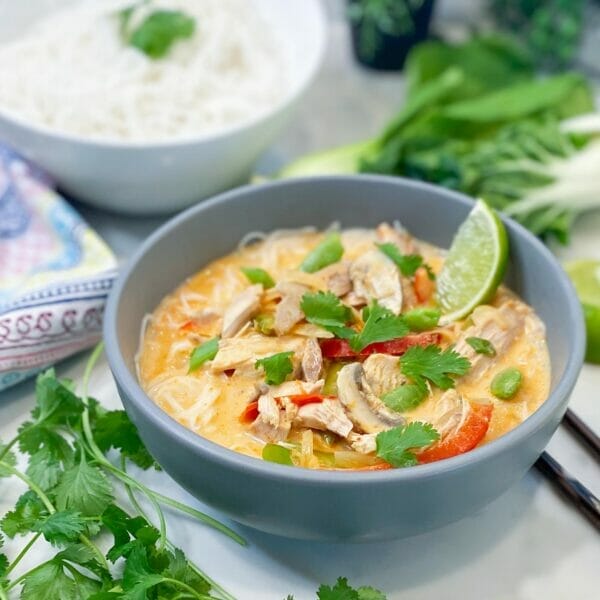
Also read: Thai Red Curry , How to Make Vegetable Soup Stock, Common Questions about Making Soup
What is Red Curry Paste
Red curry (kaeng phet) paste is a blend of herbs and spices typically used in Thai cooking – red chili peppers, garlic, shallots, lemongrass, coriander, salt and galangal root (sometimes called Thai ginger). Most also include either shrimp paste or fish sauce. Other ingredients may include turmeric, pepper, cardamom and cumin.
Red Curry Paste may or may not be gluten free, vegetarian or vegan. Read the ingredient list carefully.
Vegetables to put in Thai Red Curry Soup
Pick and choose the veggies you love most and have on hand. Aim for about 2 cups of veggies. Add them based on how long they will take to cook. For example add potatoes, carrots, squash and other hardy veggies when you add the broth so they get extra cooking time.
- mushrooms
- green beans
- baby corn (canned)
- bamboo shoots
- cauliflower
- red onion
- sweet bell peppers
- Bok choy
- broccoli
- sweet potato
- butternut/kabocha squash
- eggplant
- snap or sugar peas
- potatoes
- carrots/shredded carrots
- kale/spinach/swiss chard
- zucchini
- water chestnuts
Pro Tip – For a quick cooking option, use frozen Thai vegetables. Add at the end just to heat through.
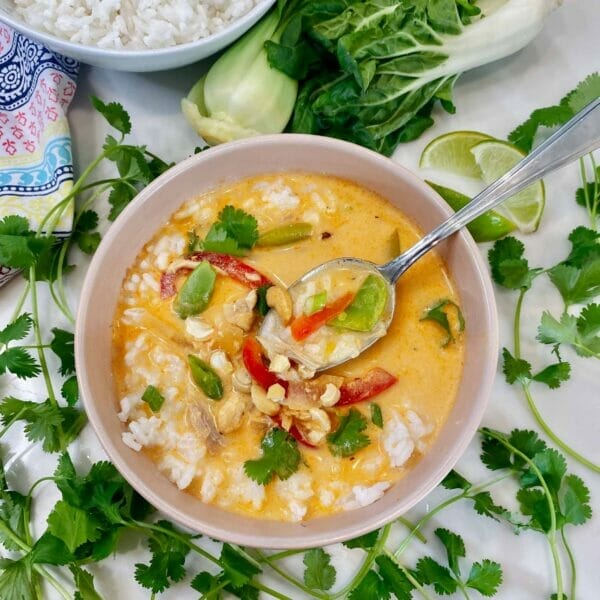
Protein Options in Red Curry Soup – Vegetarian/Vegan
There are lots of protein options for red curry as well. Choose your favourites.
Meat Options – chicken, turkey, pork, beef
Fish/Seafood Options – shrimp, scallops, mussels, white fish, salmon
Vegetarian Options – edamame, tofu, white beans, cashews, peanuts and consider high protein noodles
To make the rest of the soup vegan, double check the ingredients in your curry paste, use veggie stock and replace fish sauce with soy sauce or tamari sauce (gluten free).
Noodles or Rice for Thai Red Curry Soup
We prefer either rice or rice noodles with this soup. In my family, half of us prefer rice noodles and the other half prefers rice. Team rice noodles loves the challenge of eating those slippery little noodles while Team rice prefers the more refined dinning experience of rice on a spoon, no slurping required.
I recommend making either noodles or rice separately, not directly in the soup. This gives you much more control and avoids swollen rice or noodles in leftovers.
Personally, I think wheat based pasta isn’t ideal for Thai food – just like rice noodles aren’t ideal for Italian spaghetti and meatballs. But, of course, you are in the drivers seat and can choose whatever!
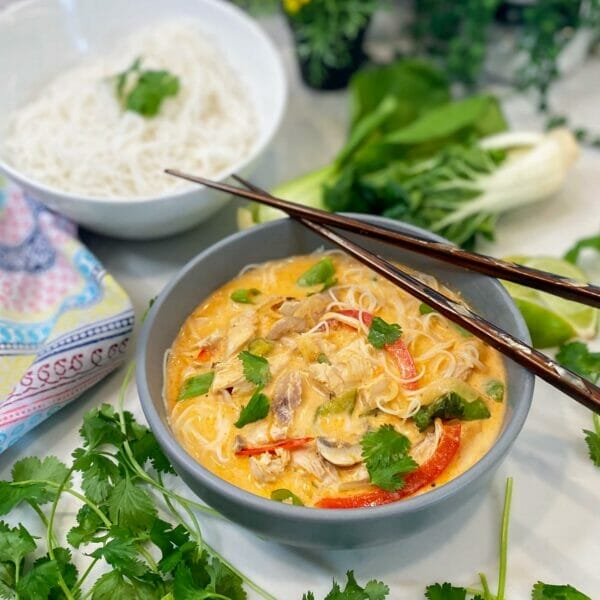
Storing & Freezing Thai Red Curry Soup
You can store this soup in the fridge for 3-5 days. You’ll notice the coconut milk will separate, but it will blend beautifully when reheated. Keep the rice or noodles separate so they don’t swell and soak up all the liquid.
It is perfectly safe to freeze this soup, but the quality may be compromised due to the coconut milk and the type of vegetables you use.
Manufacturers of coconut milk don’t recommend freezing coconut milk because it will separate and may become grainy. If you can blend thawed coconut milk, you can usually emulsify it again, but in this soup that’s tricky to do. You’ll definitely need to do some stirring. You can also add a little fresh coconut milk to make it a little smoother.
If your soup has high water vegetables or potatoes, I don’t recommend freezing as the quality will not be very pleasant.
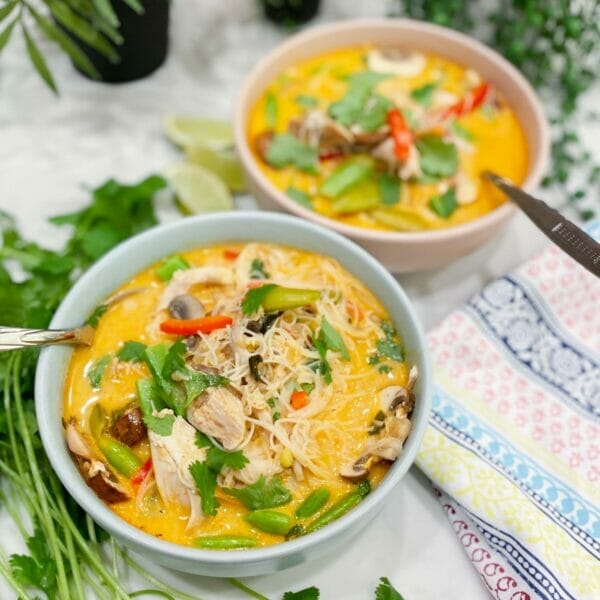
Top Tips for Making Thai Red Curry Soup
Thai red curry paste can vary greatly in flavour and spiciness depending on brand. Check the ingredient list and try different brands to find one you love best. If you’re trying a new brand, start with the smallest amount and add more to taste.
We like the Thai Kitchen brand. It’s a good introduction to Thai flavours because it’s flavourful but not very spicy. It’s also gluten free and vegetarian.
Add extra hot peppers if you like things spicy! Instead of chopping hot peppers, slice open and add whole so you can easily remove them. To make them less hot, remove some of the seeds.
Choose full-fat coconut milk for full flavour and texture. Did you know that “low fat” or “lite” coconut milk is made by simply adding water? Yup, there’s nothing special about low fat coconut milk and you pay the same price! So, why not buy the good stuff and thin it out yourself.
Fish sauce smells nasty, but really adds to the flavour. Alternatives are: oyster sauce, soy sauce, tamari sauce, mushroom powder or seaweed.
Thai herbs like lemongrass, galangal root, kaffir lime and Thai basil may be difficult to find in most North American grocery stores; try an Asian market if possible. Fresh herbs add great flavors, but if you don’t have access to them, add a little more red curry paste which is made of most of these ingredients. Instead of Thai basil, use regular fresh basil and instead of kaffir lime leaves use a touch of lime zest and lime juice.
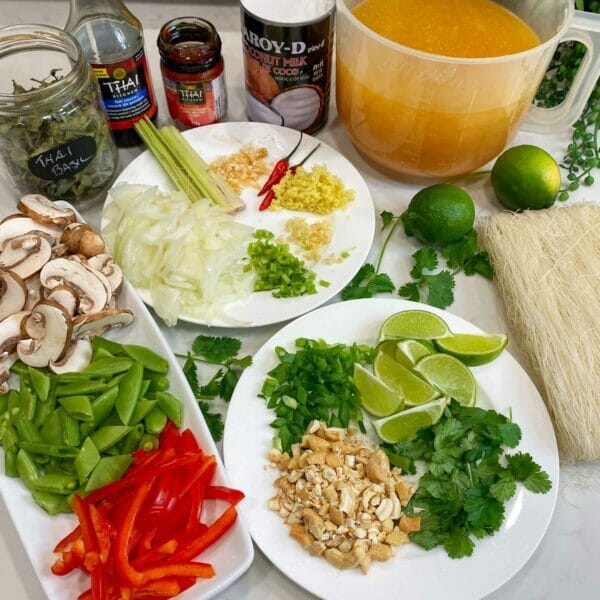
Thai Red Curry Soup Recipe
Thai Red Curry Soup
Ingredients
- 1 Tbsp canola oil
- 1 onion sliced
- 3 cloves garlic minced
- 2 Tbsp fresh ginger grated
- 2-4 Tbsp red curry paste*
- 6 cups chicken or vegetable stock
- 1 can coconut milk 14oz/400 ml
- 1 Tbsp fish sauce
- 2 tsp palm sugar (or brown sugar)
- 1-4 Thai chili pepper optional
- 1 stalk lemon grass (white part, lightly smashed) optional
- 2-4 kaffir lime leaves optional
- 2 tsp dried Thai basil optional
- 2 cups cooked chicken optional
- 3/4 cup snow peas, edamame, green beans or bok choy chopped to spoon size
- 1/2 cup red peppers sliced thin
- 3/4 cup mushroom caps sliced thin
- 1-2 Tbsp lime juice
Finishing Touches
- 3 green onions thinly sliced
- 1/2 cup roasted unsalted cashews lightly crushed
- 1/2 cup cilantro chopped
- 1/4 cup Thai basil leaves or basil chopped
- 1 lime cut into wedges
Instructions
- Heat oil in large pot over medium high heat. Add onion and cook until tender. Add garlic, ginger and red curry paste. Stir constantly and cook until fragrant about 2 minutes.
- Add stock, coconut milk, fish sauce and sugar. If using add chili peppers, lemon grass, kaffir lime leaves and dried Thai basil. Bring to a boil then reduce heat and simmer for 8 minutes.
- Stir in cooked chicken, peas, red pepper slices and mushrooms. Heat through, about 5 minutes. Remove lemon grass and kaffir lime leaves.
- Stir in lime juice. Taste and adjust seasoning. Garnish with cashews, green onions, cilantro, fresh basil leaves and lime wedges.
- Set out bowl of cooked rice or rice noodles and garnishes so each guest can add their favourites.
Notes
Nutrition Facts (per serving)

What’s the Difference Between Red Curry and Green Curry
Green curry (kaeng khiao wan) paste is very similar to red curry paste. It includes many of the same Thai ingredients (lemongrass, galangal root, kaffir, etc.). The big difference is that it is made with green hot chili peppers. And these green hot chili peppers have more heat. So green curry paste is typically hotter than red curry paste. But, of course, every brand varies, so run your own experiments and find the one you love best.
You may also find yellow curry paste which is a little milder and includes turmeric (hence the yellow colour). You can also get Panang curry paste which is similar to red curry paste but includes ground peanuts.
Ready to make a pot of tasty Thai Red Curry Soup? Will you serve it over rice or noodles? Let me know how it goes, down below in the comments or on Instagram @GetGettyS or on Facebook @GettyStewart.HomeEconomist.
Getty Stewart is a Professional Home Economist, speaker, frequent media guest and writer dedicated to putting good food on tables and agendas. She is the author of several recipe books on enjoying and preserving fruit, Founder of Fruit Share, a mom and veggie gardener. Sign up to get articles by Getty delivered to your inbox. You’ll get recipes, practical tips and great food information like this.




